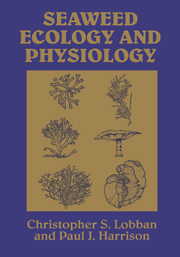Book contents
- Frontmatter
- Contents
- List of contributors
- Preface
- 1 Morphology, life histories, and morphogenesis
- 2 Seaweed communities
- 3 Biotic interactions
- 4 Light and photosynthesis
- 5 Nutrients
- 6 Temperature and salinity
- 7 Water motion
- 8 Pollution
- 9 Seaweed mariculture
- Appendix: Taxonomic classification of algae mentioned in the text
- References
- Index
1 - Morphology, life histories, and morphogenesis
Published online by Cambridge University Press: 18 December 2009
- Frontmatter
- Contents
- List of contributors
- Preface
- 1 Morphology, life histories, and morphogenesis
- 2 Seaweed communities
- 3 Biotic interactions
- 4 Light and photosynthesis
- 5 Nutrients
- 6 Temperature and salinity
- 7 Water motion
- 8 Pollution
- 9 Seaweed mariculture
- Appendix: Taxonomic classification of algae mentioned in the text
- References
- Index
Summary
Introduction: the plants and their environments
Seaweeds
The term “seaweeds” traditionally includes only macroscopic, multicellular marine red, green, and brown algae. However, each of these groups has microscopic, if not unicellular, representatives. All seaweeds at some stage in their life cycles are unicellular, as spores or zygotes, and may be temporarily planktonic (Amsler & Searles 1980). Some remain small, forming sparse but productive turfs on coral reefs (Hackney et al. 1989). The blue-green algae are widespread on temperate rocky and sandy shores (Whitton & Potts 1982) and have occasionally been acknowledged in “seaweed” floras (e.g., Setchell & Gardner 1919; Newton 1931). They are particularly important in the tropics, where large macroscopic tufts of Oscillatoriaceae and smaller but abundant nitrogen-fixing Nostocaceae are major components of the reef flora (Hackney et al. 1989). Again, there are many unicellular blue-green algae. On the other hand, some benthic diatoms – normally not considered seaweeds – form large and sometimes-abundant tube-dwelling colonies that resemble seaweeds and presumably respond to the environment in much the same way (Lobban 1989). A deep-water green, Palmoclathrus, forms a morphologically complex thallus built from an apparently amorphous matrix with a nearly uniform distribution of cells (Womersley 1971; O'Kelly 1988), and a tropical chrysophyte, Chrysonephos lewisii, forms large, Ectocarpus-like thalli (Taylor 1960). On a smaller scale are the colonial filaments of some simple red algae, such as Goniotrichum. In this book we shall consider macroscopic and microscopic benthic environments and how algae respond to those environments.
- Type
- Chapter
- Information
- Seaweed Ecology and Physiology , pp. 1 - 68Publisher: Cambridge University PressPrint publication year: 1994
- 2
- Cited by



